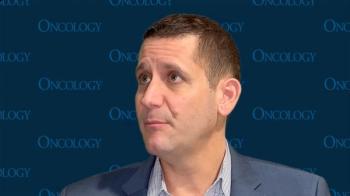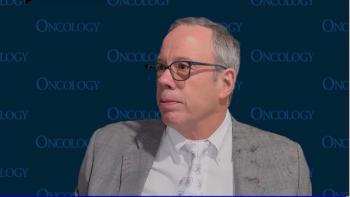
Maintenance Selinexor Shows PFS in TP53 Wild-type Endometrial Cancer
Significant progression-free survival was seen in those with TP53 wild-type advanced/recurrent endometrial cancer who were treated with maintenance selinexor.
Maintenance selinexor (Xpovio) showed a significant progression-free survival (PFS) benefit compared with placebo in a subgroup of patients with TP53 wild-type advanced/recurrent endometrial cancer, according to findings from the phase 3
Data from the trial, which were presented at the
Selinexor did not show a clinically meaningful improvement in the general study population.
“The safety profile for selinexor was generally manageable and we know that the TP53 wild-type status may represent a robust predictive biomarker for selinexor efficacy [in endometrial cancer],” lead author Giovanni Scambia, MD, chair of the Department of Health Science and Public Health of Universita Cattolica del Sacro Cuore, Italy, said in a presentation during the meeting. “These results highlight the potential opportunity to further personalize therapies and provide a strong rationale to further evaluate selinexor as a maintenance therapy.”
The randomized, double-bind, phase 3 trial included 263 patients with stage IV or first relapsed endometrial cancer. Patients must have received at least 12 weeks of platinum-based chemotherapy and must have shown a partial response (PR) or complete response (CR) to first-line chemotherapy. Prior surgery, radiation, or hormone therapy was permitted.
Patients were randomized 2:1 to receive either oral 80 mg of selinexor or placebo weekly. Patients were stratified based on cancer stage (primary stage IV vs recurrent) and response (complete vs partial).
In the arms receiving selinexor and placebo, respectfully, 97.4% and 94.4% were white. The median age was 64 years old (40-81) for the selinexor arm and 61.5 years (33-74) for the placebo arm. More than 80% of patients in both groups had endometrioid cancer. In the selinexor arm, 44.2% of patients had primary stage IV disease at time of therapy, and 53.2% had recurrent disease. In the placebo arm, 47.2% had primary stage IV disease, and 50.0% had recurrent disease.
The primary end point for this study was investigator-assessed PFS. Secondary end points included overall survival (OS) and time to first subsequent therapy (TFST). Select exploratory end points included histological subtype and molecular subclassification assessed by DNA sequencing and immunohistochemistry (IHC), specifically regarding TP53 mutation status, microsatellite instability status, and POLE-EDM.
In those with microsatellite stable (MSS)/mismatch repair proficient (pMMR) disease, the median PFS with selinexor was not reached (95% CI, 19.3-NR) compared with 4.9 months (95% CI, 2.0-NR) with placebo (HR, 0.32; 95% CI, 0.16-0.64; one-sided P = .0004). Median PFS in those with microsatellite instability–high (MSI-H)/mismatch repair deficient (dMMR) endometrial cancer was 13.1 months (95% CI, 3.6-NR) vs 3.7 months (95% CI, 1.9-NR) with selinexor and placebo, respectively (HR, 0.45; 95% CI, 0.16-1.27; one-sided P = .0643).
Preliminary OS in those with TP53 wild-type showed no response (NR) with selinexor (NR, NR) or with placebo (35.19, NR; HR, 0.76; 95% CI, 0.36-1.59; one-sided P = .24) with a median follow up of 28.9 months. Preliminary OS in those with TP53 wild-type/pMMR showed NR with selinexor (NR, NR) and 35.19 months with placebo (28.68, NR; HR, 0.57; 95% CI, 0.24-1.35; one-sided P = .098) with a median follow up of 31.6 months. In those with TP53 wild-type/dMMR, there was no response with either treatment (HR, 0.62; 95% CI, 0.06-6.81; one-sided P = .35).
In terms of treatment-emergent adverse events (TEAEs) in patients with TP53 wild-type, any-grade toxicities in the selinexor and placebo groups, respectively, included nausea (90% vs 34%), vomiting (60% vs 11%), diarrhea (42% vs 37%), constipation (33% vs 40%), and asthenia (36% vs 26%). Grade 3/4 TEAEs in the selinexor arm included neutropenia (18%), nausea (12%), thrombocytopenia (10%), and fatigue (8%). In the placebo arm, these grade 3/4 TEAEs were constipation (6%), abdominal pain (3%), and vomiting (3%).
TEAEs resulted in discontinuation of treatment in 16% of the selinexor arm and none in the control arm.
Currently, selinexor is being assessed as maintenance therapy after systematic therapy for patients with p53 wild-type, advanced or recurrent endometrial carcinoma in the ongoing ENGOT-EN20/GOG-3083/ XPORT-EC-042 (NCT05611931).3
References
- Scambia G, Vergote I, Hamilton E, et al. Selinexor maintenance for patients with TP53wt advanced or recurrent endometrial cancer: long-term follow up of efficacy and safety subgroup analysis of the ENGOT-EN5/GOG-3055/SIENDO study. Presented at: 2023 Annual Global Meeting of the International Gynecologic Cancer Society; November 5-7, 2023; Seoul, Korea.
- Vergote I, Pérez-Fidalgo JA, Hamilton EP, et al. Oral selinexor as maintenance therapy after first-line chemotherapy for advanced or recurrent endometrial cancer. J Clin Oncol. Published online September 5, 2023. doi:10.1200/jco.22.02906
- Vergote I, Mirza MR, Coleman RL, et al. ENGOT-EN20/GOG-3083/xport-EC-042: A phase 3, randomized, placebo-controlled, double-blind, multicenter trial of selinexor in maintenance therapy after systemic therapy for patients with P53 wild-type, advanced or recurrent endometrial carcinoma. J Clin Oncol. 2023;41(16_suppl):TPS5627-TPS5627. doi:10.1200/jco.2023.41.16_suppl.tps5627
Newsletter
Stay up to date on recent advances in the multidisciplinary approach to cancer.

















































































